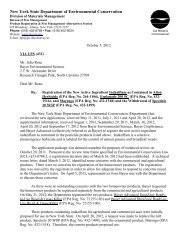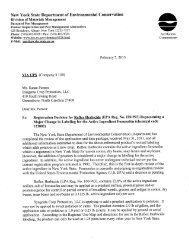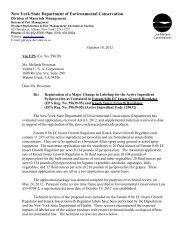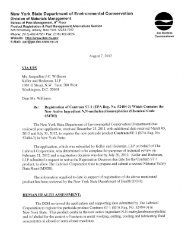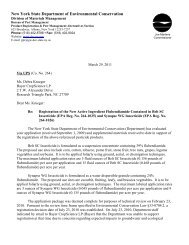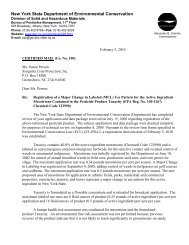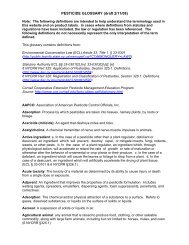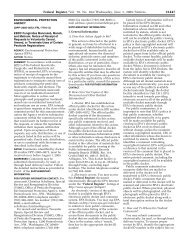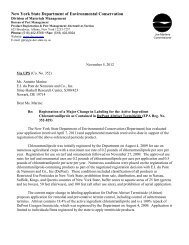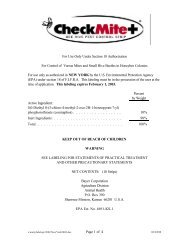Amitraz
Amitraz
Amitraz
Create successful ePaper yourself
Turn your PDF publications into a flip-book with our unique Google optimized e-Paper software.
For the control of mites<br />
(varroatosis) on honey bees<br />
Active ingredient:<br />
<strong>Amitraz</strong>: N’-(2,4-dimethylphenyl)<br />
N-[[(2,4-dimethylphenyl)imino]methyl]-<br />
N-methylmethanimidamide.......................3.33%<br />
FIRST AID<br />
If swallowed:<br />
•Call a poison control center or doctor<br />
immediately for treatment advice.<br />
•Have person sip a glass of water if able<br />
to swallow.<br />
•Do not induce vomiting unless told to by<br />
a poison control center or doctor.<br />
•Do not give anything by mouth to an<br />
unconscious person.<br />
If on skin or clothing:<br />
•Take off contaminated clothing.<br />
•Rinse skin immediately with plenty of<br />
water for 15-20 minutes.<br />
•Call a poison control center or doctor for<br />
treatment advice.<br />
If in eyes:<br />
•Hold eye open and rinse slowly and<br />
gently with water for 15-20 minutes.<br />
• Remove contact lenses, if present, after<br />
Net contents: 10 plastic strips<br />
the first 5 minutes, then continue rinsing.<br />
• Call a poison control center or doctor for<br />
treatment advice.<br />
If inhaled:<br />
• Move person to fresh air.<br />
• If person is not breathing, call 911 or an<br />
ambulance, then give artificial respiration,<br />
preferably mouth-to-mouth if possible.<br />
• Call a poison control center or doctor for<br />
further treatment advice.<br />
Have the product container or label with<br />
you when calling a poison control center<br />
or doctor or going for treatment.<br />
For TRANSPORTATION EMERGENCIES,<br />
c a l l 2 4 h o u r s a d a y C H E M T R E C<br />
1-800-424-9300. For MEDICAL EMERGENCY,<br />
c a l l 2 4 h o u r s a d a y P R O S A R<br />
1-866-257-2596.<br />
For PRODUCT USE Information<br />
Call 1-212-930-5101.<br />
PRECAUTIONARY STATEMENTS<br />
Hazardous to humans and domestic animals<br />
Warning: May be fatal if absorbed through the skin. Harmful if swallowed or<br />
inhaled. Do not get in eyes, on skin, or on clothing. Avoid inhalation of product<br />
vapor when opening the sealed packet of strips. Avoid contact with skin and eyes<br />
and wear chemical-resistant gloves when handling the strips. Wash thoroughly<br />
with soap and water after handling and before eating, drinking, chewing gum,<br />
using tobacco or using the toilet. Wear coveralls worn over short-sleeved shirt<br />
and short pants, socks and chemical-resistant footwear and chemical-resistant<br />
gloves. Remove and wash contaminated clothing before reuse.<br />
California Warning: This product contains a chemical known to the State of<br />
California to cause birth defects or other reproductive harm.<br />
Environmental hazards<br />
This pesticide is highly toxic to birds, fish and aquatic invertebrates. Do not apply<br />
directly to any body of water. Do not contaminate water when disposing of used<br />
strips.<br />
Expiration date: 24 months - Batch number/Date of manufacture: See edge of pack<br />
TM<br />
KEEP OUT OF REACH OF CHILDREN<br />
WARNING<br />
For use only as authorized in the State in which the U.S. Environmental<br />
Protection Agency (EPA) has granted a FIFRA Section 18 emergency<br />
exemption. This Labeling must be in the possession of<br />
the user at the time of application.<br />
Inert ingredients:...........96.67%<br />
Total:.............................100.00%<br />
Net contents: 5.29oz. (150g.)<br />
APV US01 10-12
DIRECTIONS FOR USE<br />
Manufactured for:<br />
Véto-pharma S.A.<br />
14 avenue du Québec<br />
91140 Villebon-sur-Yvette - FRANCE<br />
TM<br />
U.S. Agent:<br />
Arysta LifeScience America Inc.<br />
1450 Broadway - New York, NY 10018<br />
Tel: 212-930-5101<br />
strips<br />
It is a violation of Federal law to use this product in a manner inconsistent with its labeling.<br />
Apivar is a sustained-release plastic strip designed for use in beehives to control the<br />
parasitic mite (Varroa destructor) on honey bees.<br />
For varroa treatment<br />
To control varroa mite, remove honey supers before application of Apivar. Use 2 Apivar strips<br />
per brood chamber. Separate the double strip and hang each strip between two comb frames<br />
inside the brood area or the bee cluster, with a minimum distance of 2 frames between strips.<br />
Suspend Apivar strips in the brood chamber in such a way that the bees can walk on both sides<br />
of the strips. Leave strips inside the hive for 42 days minimum, and then remove. In case of<br />
movement inside the beehive far from the strips, a repositioning of the strips should be done into<br />
the bee cluster, and the strips left in place for 14 more days before removal. Strips must be<br />
removed after a maximum of 56 days. DO NOT re-use the strips.<br />
Timing:<br />
Hang Apivar strips in the hives one treatment in the spring or one treatment in the fall if varroa<br />
mite infestations have reached treatment threshold. All Apivar strips should be removed 2 weeks<br />
before the honey flow starts.<br />
If mite infestation reaches treatment thresholds in autumn, remove surplus honey supers before<br />
using Apivar.<br />
Withholding period for honey collection:<br />
DO NOT USE APIVAR STRIPS WHEN HONEY SUPERS ARE PRESENT.<br />
Wait 14 days after removing strips before placing honey supers on hive.<br />
Resistance management:<br />
This pest scenario is highly susceptible to resistance. <strong>Amitraz</strong> belongs to Insecticide Resistance<br />
Action Committee (IRAC) Group 19. Some individuals in the Varroa mite population may be<br />
naturally resistant to Apivar. Over time, resistant Varroa mites will reproduce and dominate the<br />
mite population if Apivar if used repeatedly in the same location. To delay resistance, rotate this<br />
product with other Varroa mite control products in different chemical classes so that the potential<br />
for Varroa mite populations to develop resistance is minimized. Pesticide use should be based on<br />
an integrated pest management (IPM) program that includes monitoring, record keeping, and<br />
considers cultural, biological and other chemical control practices. Using IPM with strict adherence<br />
to label directions (specifically the removal of amitraz strips after 56 days) on approved treatments<br />
reduces the risks of encouraging the development of resistant Varroa mite populations. Correctly<br />
identify the pest and ensure that treatment thresholds are met prior to use. Monitor treated pest<br />
populations for resistance development and incorporate resistance management practices into a<br />
control program. Report performance issues due to the development of amitraz resistance in target<br />
pest.<br />
Storage and disposal:<br />
Do not contaminate water, food or feed by storage or disposal.<br />
Pesticide storage:<br />
Store in a cool, dry area, out of direct sunlight, and away from other pesticides that may contaminate<br />
the strips. To prevent contamination, store this product in the original container and away<br />
from food or feed.<br />
Pesticide disposal:<br />
To avoid wastes, use all strips in this container by application according to label directions. Offer<br />
remaining product to an approved waste disposal facility or pesticide disposal program.<br />
Container disposal: Unused strips should be stored in a cool, dark area. Any unused,<br />
unregistered product must either be returned to the manufacturer or distributor in unopened<br />
packaging or disposed of in accordance with the Resource Conservation Recovery Act following<br />
the expiration of this emergency exemption.<br />
Warranty and Disclaimer: To the extent consist with applicable law, this product is to be used<br />
only in accordance with the directions on the label. The user assumes the risk to persons or<br />
property that arises from any use of the product in a way that is inconsistent with the label.<br />
See Supplemental Label for State and File Symbol<br />
EPA Est. No. 87242-FRA-001
Doc Id: 534198<br />
For use only as authorized in the State in which the U.S. Environmental Protection Agency (EPA) has granted a FIFRA Section 18<br />
emergency exemption. This Labeling must be in the possession of the user at the time of application.<br />
STATE: NEW YORK<br />
For the control of mites (varroatosis) on honey bees<br />
Emergency exemption use direction<br />
APIVAR STRIPS - SUPPLEMENTAL LABEL<br />
EPA File Symbol: 13-NY-02<br />
DIRECTIONS FOR USE<br />
It is a violation of Federal law to use this product in a manner inconsistent with its labeling.<br />
EXPIRATION DATE: December 31, 2013<br />
EPA Est. No. 87242-FRA-001<br />
ACTIVE INGREDIENT: <strong>Amitraz</strong>: N’-(2,4-dimethylphenyl)-N-[[(2,4-dimethylphenyl)imino]methyl]-N-methylmethanimidamide 3.33%<br />
INERT INGREDIENTS 96.67%<br />
TOTAL: 100.00%<br />
Apivar is a sustained-release plastic strip designed for use in beehives to control the parasitic mite (Varroa destructor) on honey bees.<br />
For varroa treatment - To control varroa mites, remove honey supers before application of Apivar. Use 2 Apivar strips per brood<br />
chamber. Separate the double strip and hang each strip between two comb frames inside the brood area or the bee cluster, with a minimum<br />
distance of 2 frames between strips. Suspend Apivar strips in the brood chamber in such a way that the bees can walk on both sides of the<br />
strips. Leave strips inside the hive for 42 days, and then remove. In case of movement of bees inside the beehive away from the strips,<br />
reposition the strips into the bee cluster, and leave strips in place for 14 more days before removal. Strips must be removed after a maximum<br />
of 56 days. DO NOT re-use the strips.<br />
Timing:<br />
A maximum of two treatments, one in the spring and/or one in the fall may be made per year if varroa mite infestations reach treatment<br />
threshold. All Apivar strips should be removed 2 weeks before the honey flow starts.<br />
If mite infestation reaches treatment thresholds in autumn, remove surplus honey supers before using Apivar.<br />
Withholding period for honey collection:<br />
DO NOT USE WHEN HONEY SUPERS ARE PRESENT. Wait 14 days after removing strips before placing honey supers on hive.<br />
Feb 5, 2013<br />
Resistance-management: This pest scenario is highly susceptible to resistance. <strong>Amitraz</strong> belongs to Insecticide Resistance Action Committee<br />
(IRAC) Group 19. Some individuals in the Varroa mite population may be naturally resistant to Apivar ® . Over time, resistant Varroa mites will<br />
reproduce and dominate the mite population if Apivar is used repeatedly in the same location. To delay resistance, rotate this product with<br />
other Varroa mite control products in different chemical classes so that the potential for Varroa mite populations to develop resistance is<br />
minimized. Pesticide use should be based on an integrated pest management (IPM) program that includes monitoring, record keeping, and<br />
considers cultural, biological and other chemical control practices. Using IPM with strict adherence to label directions (specifically the<br />
removal of amitraz strips after 56 days) on approved treatments reduces the risks of encouraging the development of resistant Varroa mite<br />
populations. Correctly identify the pest and ensure that treatment thresholds are met prior to use. Monitor treated pest populations for<br />
resistance development and incorporate resistance management practices into a control program. Report performance issues due to the<br />
development of amitraz resistance in target pest.<br />
Warranty and Disclaimer: To the extent consist with applicable law, this product is to be used only in accordance with the directions on the<br />
label. The user assumes the risk to persons or property that arises from any use of the product in a way that is inconsistent with the label.
STORAGE AND DISPOSAL<br />
Do not contaminate water, food or feed by storage or disposal.<br />
PESTICIDE STORAGE: Store in a cool, dry area, out of direct sunlight, and away from other pesticides that may contaminate the<br />
strips. To prevent contamination, store this product in the original container and away from food or feed.<br />
PESTICIDE DISPOSAL: To avoid wastes, use all strips in this container by application according to label directions. Offer<br />
remaining product to an approved waste disposal facility or pesticide disposal program.<br />
CONTAINER<br />
DISPOSAL:<br />
FIRST AID<br />
IF SWALLOWED:<br />
IF ON SKIN OR<br />
CLOTHING:<br />
Unused strips should be stored in a cool, dark area. Any unused, unregistered product must either be<br />
returned to the manufacturer or distributor in unopened packaging or disposed of in accordance with the<br />
Resource Conservation Recovery Act following the expiration of this emergency exemption.<br />
KEEP OUT OF REACH OF CHILDREN<br />
WARNING<br />
Call a poison control center or doctor immediately for treatment advice.<br />
Have person sip a glass of water if able to swallow.<br />
Do not induce vomiting unless told to by a poison control center or doctor.<br />
Do not give anything by mouth to an unconscious person.<br />
Take off contaminated clothing.<br />
Rinse skin immediately with plenty of water for 15-20 minutes.<br />
Call a poison control center or doctor for treatment advice.<br />
IF IN EYES: Hold eye open and rinse slowly and gently with water for 15-20 minutes.<br />
Remove contact lenses, if present, after the first 5 minutes, then continue rinsing.<br />
Call a poison control center or doctor for treatment advice.<br />
IF INHALED: Move person to fresh air.<br />
If person is not breathing, call 911 or an ambulance, then give artificial respiration, preferably mouthto-mouth<br />
if possible.<br />
Call a poison control center or doctor for further treatment advice.<br />
Have the product container or label with you when calling a poison control center or doctor or going for treatment. For<br />
TRANSPORTATION EMERGENCIES, call 24 hours a day CHEMTREC 1-800-424-9300. For MEDICAL EMERGENCY, call 24 hours a day<br />
PROSAR 1-866-257-2596. For PRODUCT USE Information Call 1-212-930-5101.<br />
PRECAUTIONARY STATEMENTS<br />
HAZARDOUS TO HUMANS AND DOMESTIC ANIMALS<br />
WARNING: May be fatal if absorbed through the skin. Harmful if swallowed or inhaled. Do not get in eyes, on skin, or on clothing. Avoid<br />
inhalation of product vapor when opening the sealed packet of strips. Avoid contact with skin and eyes and wear chemical-resistant gloves<br />
when handling the strips. Wash thoroughly with soap and water after handling and before eating, drinking, chewing-gum, using tobacco or<br />
using the toilet. Wear coveralls worn over short-sleeved shirt and short pants, socks, footwear and chemical-resistant gloves. Remove and<br />
wash contaminated clothing before reuse.<br />
CALIFORNIA WARNING: This product contains a chemical known to the State of California to cause birth defects or other reproductive harm.<br />
ENVIRONMENTAL HAZARDS<br />
This pesticide is highly toxic to birds, fish and aquatic invertebrates. Do not apply directly to any body of water. Do not contaminate water<br />
when disposing of used strips.<br />
Authorization holder: U.S. Agent:<br />
Véto-pharma S.A. Arysta LifeScience America Inc.<br />
14 avenue du Québec New York, NY 10018<br />
91140 Villebon-sur-Yvette – France 1450 Broadway<br />
Tel: 212-930-5101



